3 June 1828: Fugue at midnight
Posted by Richard on UTC 2018-06-03 11:22 Updated on UTC 2018-06-27
Schubert's close friend and fellow composer, Franz Lachner (1803-1890), left an interesting anecdote of Schubert's good-natured willingness to compose music on request:
In 1828, the third of June, Schubert and I were invited by [Johann] Schickh, the publisher of the Modezeitung to a country party in Baden near Vienna. In the evening Schickh said to us: 'We want to go early tomorrow to Heiligenkreuz to hear the famous organ there; perhaps you could compose a little something and perform it there?'
Schubert suggested that we each compose a fuge for four hands. We had them both finished by midnight.
On the next day - at six o'clock in the morning - we drove to Heiligenkreuz, where both fugues were performed in the presence of several people from the abbey.
Schubert's Fugue in E-Minor was published posthumously by [Anton] Spina. My fugue has not yet been published. Schubert died in November of the same year.
Im Jahre 1828, den 3. Juni, wurden Schubert und ich von dem Herausgeber der Modezeitung, Herrn Schickh, zu einer Landpartie nach Baden bei Wien eingeladen; des Abends sagte uns Schickh: »Wir wollen morgen früh nach Heiligenkreuz, um die dortige berühmte Orgel zu hören; vielleicht könntet Ihr noch eine Kleinigkeit komponieren und sie dort aufführen?« - Schubert schlug die Komposition einer vierhändigen Fuge vor, welche auch gegen Mitternacht von beiden Teilen vollendet war. Am andern Tag - früh 6 Uhr - fuhren wir nach Heiligenkreuz, wo beide Fugen in Gegenwart mehrerer Klosterherren aufgeführt wurden. Schuberts Fuge in e-Moll ist unter seinen nachgelassenen Werken bei Spina abgedruckt. Meine Fuge ist noch ungedruckt. Im November desselben Jahres starb Schubert.
Deutsch, Otto Erich, ed. Schubert: Die Erinnerungen Seiner Freunde. Wiesbaden: Breitkopf & Härtel, 1997. [DE]. p. 224f.
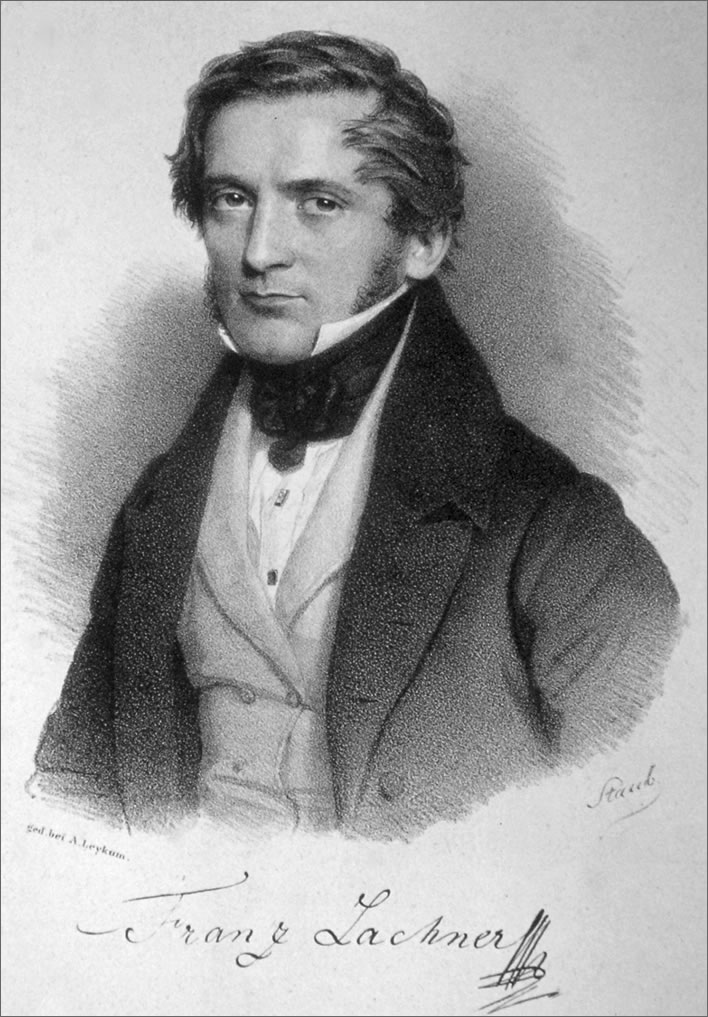
Franz Lachner in a lithogaph by Andreas Staub (1806-1839), c. 1830.
Schubert's Fugue in E-Minor, Opus 132, D 952, was actually printed by Diabelli in 1844. Anton Spina became the commercial director of Diabelli in 1824, so it was natural for Lachner to speak of Spina in this respect.
Lachner extended his own Fugue around 1835. The work finally appeared as 'Introduction and Fugue in D-Minor for four hands', Opus 62 in Leipzig in 1873.
Background
Let's look at some of the background to Lachner's anecdote.
Firstly, for those few readers not immediately familiar with the geography of the state of Lower Austria, here is the situation there around 1830:
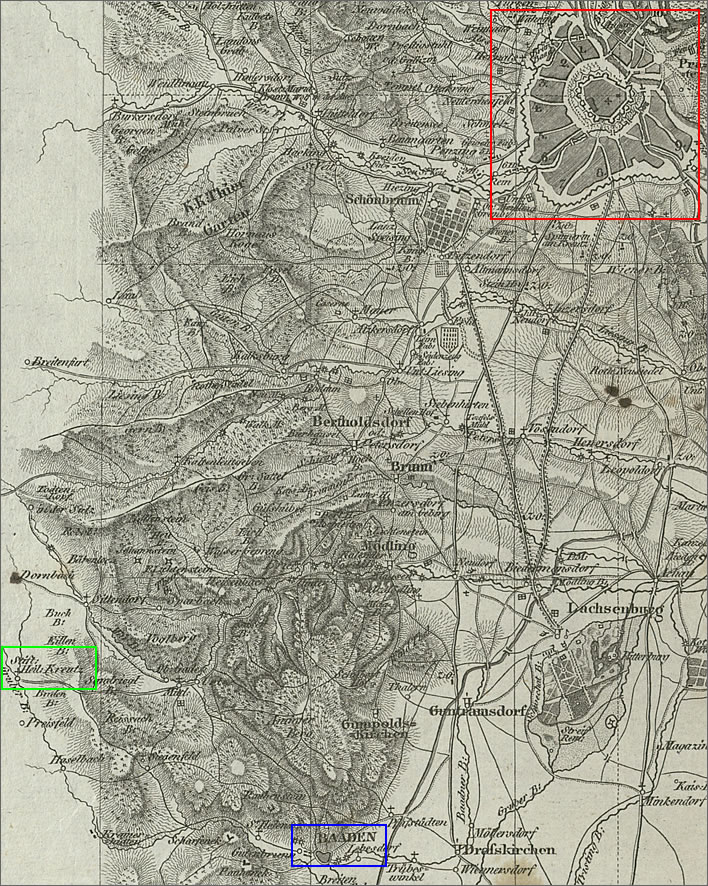
Vienna [red box], Baden [blue box], Heiligenkreuz [green box]. A detail taken from the map Wien und Umgebung, 'Vienna and Surroundings', drawn by Eduard Gurk and published by Tranquillo Mollo in 1830.Image: mapy.mzk.cz. [Click to show a larger image in a new browser tab, 2442 x 3056 px]
The forested area that runs almost from the top to the bottom of the map is the famous Wienerwald, the 'Vienna Woods', an important area of retreat and recreation for the huddled masses of Vienna. The journey from Vienna to Baden (not to be confused with the other spa town in south-western Germany, Baden-Baden) is about 40 km, the journey from Baden to Heiligenkreuz is about another 12 km following the river Schwechat along the scenic Helenental valley.
Baden
Baden bei Wien– the town's precise title – was renowned for its sulphur baths, widely held to be capable of curing most diseases and alleviating most ailments.
As was probably the case in all the spas of the time throughout Europe, there was profit to be made in providing the distractions sought after by patrons when they were not dipping themselves into or even drinking these foul waters, distractions which included all the pleasures known to man. The guest, male or female, might leave with more diseases than they brought with them. Readers may remember our encounter with the snake pit of the spa at Baden in the story of Ludovica von Schober, a sister of Schubert's soulmate Franz von Schober.
In short, there was everything in Baden to amuse the invited guests of Johann Schickh (1770-1835), the rich Viennese textile dealer and the publisher of the Moden-Zeitung, more correctly the Wiener Zeitschrift für Kunst, Literatur, Theater und Mode. Once more we test the reader's memory of our piece on Schubert's Die Forelle, the very first printed version of which appeared in the Moden-Zeitung.
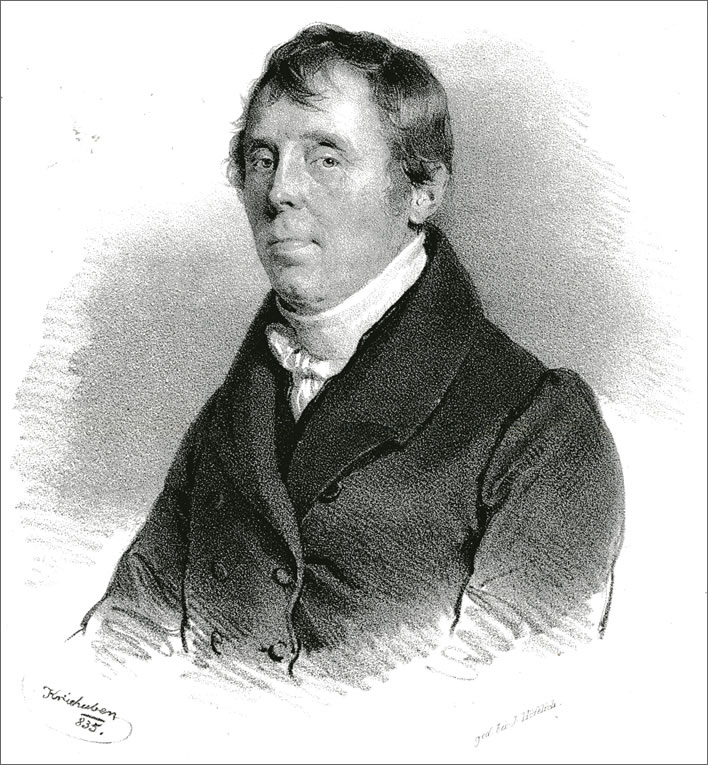
Johann Valentin Schickh (1770-1835) in 1835 (his death year) in a lithograph from an image by Josef Kriehuber (1800–1876).
Heiligenkreuz Abbey
The Cistercian Stift Heiligenkreuz, an abbey with a teaching function, had been founded in 1133. Ever since then it had expanded and accumulated riches. Nowadays it is the largest Cistercian abbey in Europe.
The magnet for the visit as described by Lachner was the organ in the abbey church, built by the renowned organ builder Ignaz Kober (1756-1813) in 1804. That is probably the case, but Alois Niemetz, a leading authority on the abbey, suggests that there may have been other reasons for their trip to Heiligenkreuz:
The impetus for this journey may have also been the newly completed road through the Helenental. Bofore this the route between Baden and Heiligenkreuz ran over the Urthelstein, which was very troublesome. The mountain ridge, which abuts right on to the river Schwechat, could only be overcome when a pair of oxen were added at the head of the coach. On the initiative of the Mayor of Baden and Abbot Xaver a road was built starting in 1826, parts of which had to be cut through the rock. The construction of the road took almost a year.
Reason enough to make the journey in a carriage along the new road, marvel at the surroundings and at the end of the trip give a concert on the modern organ equipped with wonderful solo voices.
Der Anstoß zu dieser Reise mag auch die vor kurzem fertiggestellte Straße durchs Helenental gewesen sein. Vordem führte der Fahrweg von Baden nach Heiligenkreuz über den Urthelstein. was sehr mühsam war. Der bis in die Schwechat hineinreichende Bergrücken konnte nur bezwungen werden, wenn man der Kalesche ein Ochsenpaar vorspannte. Über Betreiben des Badener Kreishauptmannes und mit Hilfe des Abtes Xaver wurde im Jahre 1826 der Bau der Straße mit der Durchbrechung des Felsens begonnen, die fast ein Jahr beanspruchte. Grund genug, nun auf der neuen Straße das jetzt erschlossene Helenental in einem Reisewagen bequem zu durchfahren und die anmutige Gegend zu genießen und am Ziel der Reise auf der modernen, mit prächtigen Solostimmen ausgestatteten, großen Orgel zu konzertieren.
Niemetz, Alois. 800 Jahre Musikpflege in Heiligenkreuz, Heiligenkreuzerverlag, 1977, ISBN 3-85105-1041. p93.
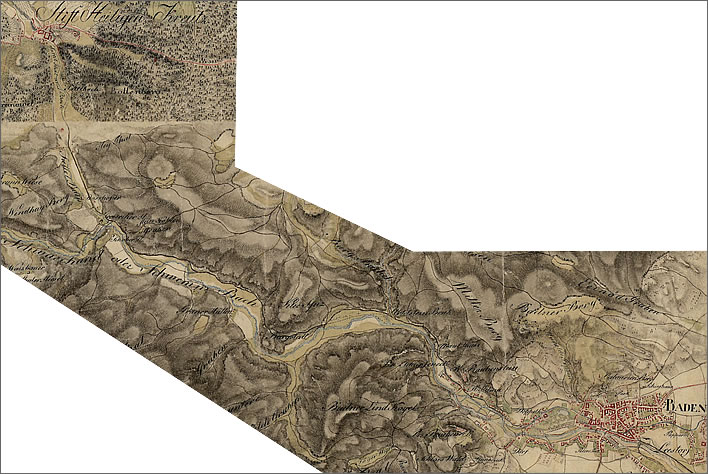
The difficult passage of the Helenental between Baden and Heiligenkreuz before the new road was built in 1827, here in a map from the Franziszeische Landesaufnahme / Österreich ob und unter der Enns from around 1818. [Click to show a larger image in a new browser tab, 3015 x 2019 px]
If, reader, on fire with enthusiasm, you now pack a bag and your camera and cut along to Heiligenkreuz to see the organ on which the Franzes Schubert and Lachner blasted out their four-handed fugues on the morning of 4 June, 190 years ago, be aware: things have changed in those two centuries.
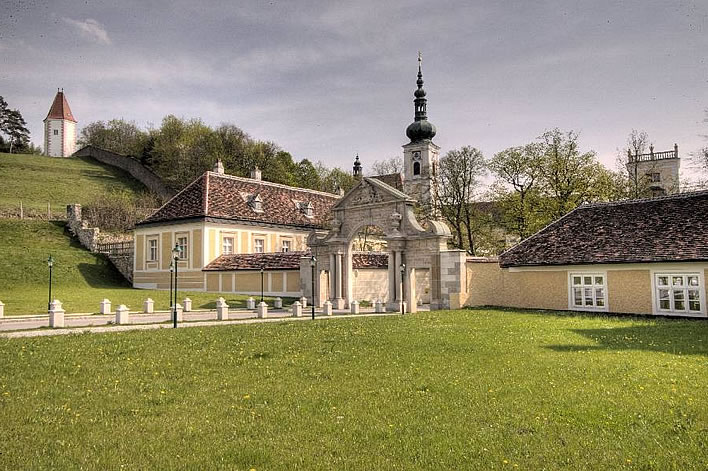
The entrance to Heiligenkreuz Abbey. Image: ©Zisterzienserstift Heiligenkreuz / Österreich Journal / Michael Mössmer [and many more images at the link].

An aerial view of Heiligenkreuz Abbey. The courtyard with the Holy Trinity statue is top centre, the nave runs right to left from there. Image: Phil.-Theol. Hochschule Benedikt XVI. Heiligenkreuz.
Surviving the Baroque
The oldest part of Heiligenkreuz is the abbey church, dedicated in 1137. Its backbone is a long nave with three aisles running west to east that culminates in a short transept and beyond that, a choir. The group was executed in a severely simple Romanesque style: ten great, rounded arches striding down the nave. In the 13th century the original Romanesque choir was massively extended in High Gothic style and became a 'choir hall', in order to accommodate the flood of pilgrims to the Abbey.
The era of the Baroque was a time when complexity and extreme skills became the definition of artistic beauty – a surface without gold leaf, angels, cherubs and putti playing trombones was an offence to the eye. No building was safe.
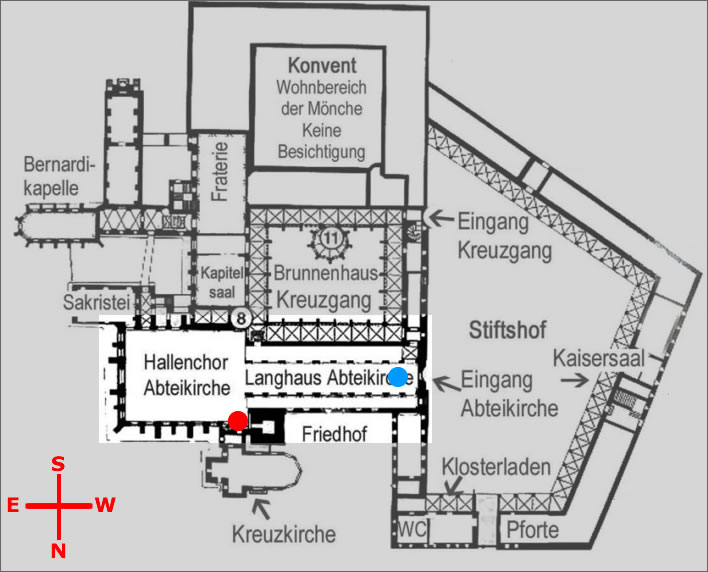
A plan of Heiligenkreuz Abbey. The location of Kober's organ from 1804 to 1950 is marked by the blue dot, the present location by the red dot. Note that the source plan has been drawn 'upside down', that is, north is at the bottom, not the top and west is on the right, not the left. Image: source base plan, Stift Heiligenkreuz.
In the Heiligenkreuz church the great window at the eastern end of the gothic choir hall was bricked up and an immense Baroque altar (gold leaf, angels etc.) parked in front of it. The construction of Kober's organ was part of this process, too. At the western end of the nave, where the worshipper enters the church from the abbey courtyard, the barbarians built a large platform over the door that extended three arches down the nave, thus drastically shortening its magnificent length by almost a third. Worse still, the platform was just a little over half the height of the arches, thus violating grotesquely the structural lines of the nave.
Kober's organ
Upon this platform Ignaz Kober built his organ. Around it and upon it flew and stood angels and cherubs, with trombones a-plenty. This was the organ that the Franzes Lachner and Schubert saw before them.
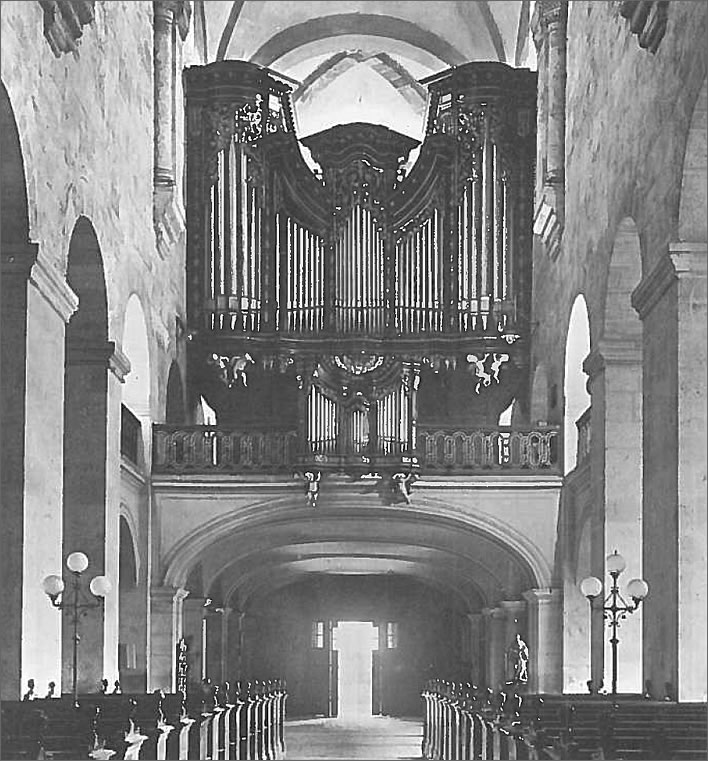
The great organ built by Ignaz Kober in 1804 in the Heiligenkreuz Abbey church. The photograph is of Kober's organ in 1949, the year before it was relocated to the transept. The statues have already been removed in preparation.
The black and white photographs of the Kober organ in this section are all taken from Niemetz, op. cit.
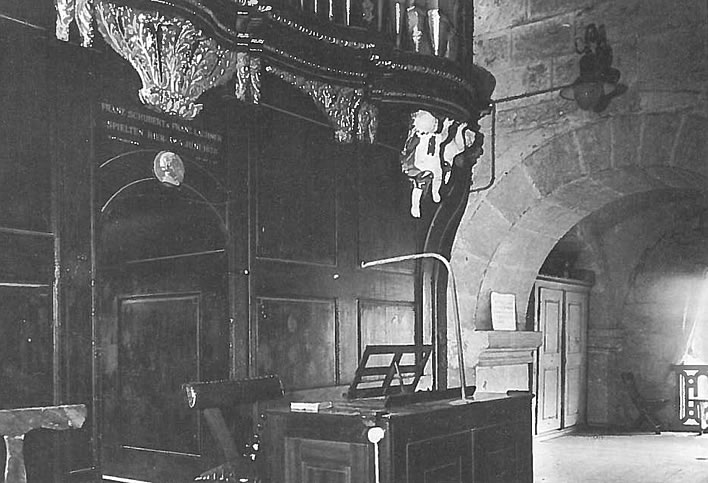
In this photograph from 1928 the organ is in its original position at the western end of the great Romanesque nave. We are standing on the platform. There is a small set of pipes out of shot on the right of the photograph which hides the organist from view. One of the brutally truncated romanesque arches can be seen at the side of the organ.
1928 was the Schubert-Jahr, the centenary of Franz Schubert's death. There is a plaque and an inscription to him above the central archway in the base of the organ:Franz Schubert und Franz Lachner spielten hier 4. Juni 1828, 'Franz Schubert and Franz Lachner played here 4 June 1828'.
From the end of the 19th century onwards, some Austrian churches took steps to undo the vandalism of the Baroque period. Heiligenkreuz was one of them. In 1950 the hideous platform was pulled down and Kober's organ was relocated to the north transept. The base was reconstructed and the set of pipes behind the organist integrated into the main structure.
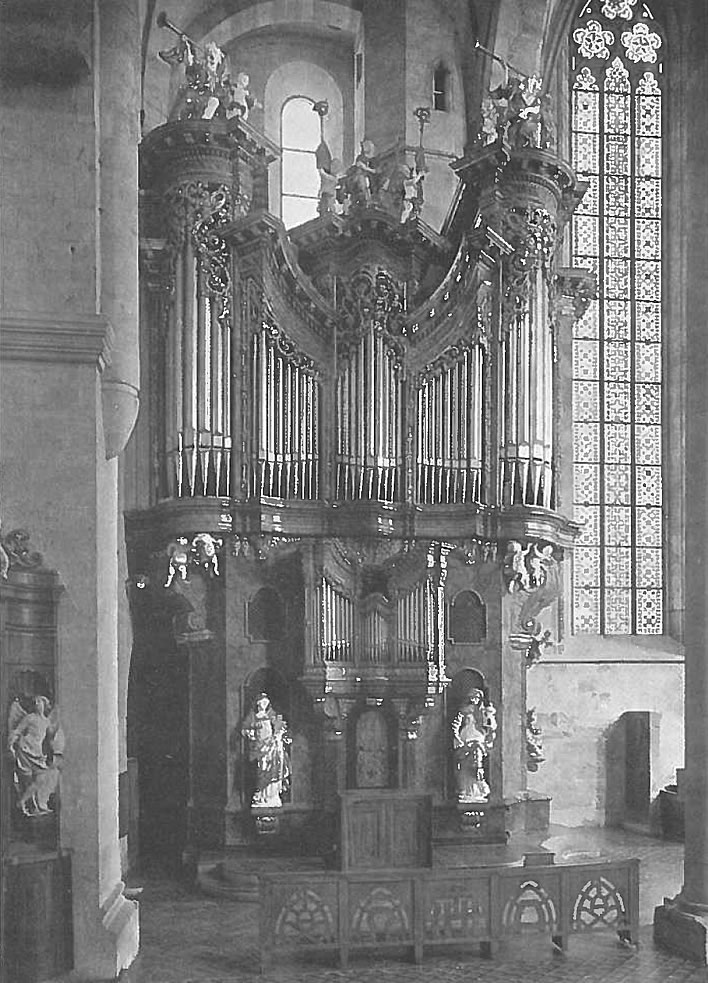
The organ in the north transept in 1952, after its removal and restoration. The new base can be seen, with the minor pipe group now suspended on its front. The saints, angels, cherubs and hornblowers are back, too. The console is centre-front.
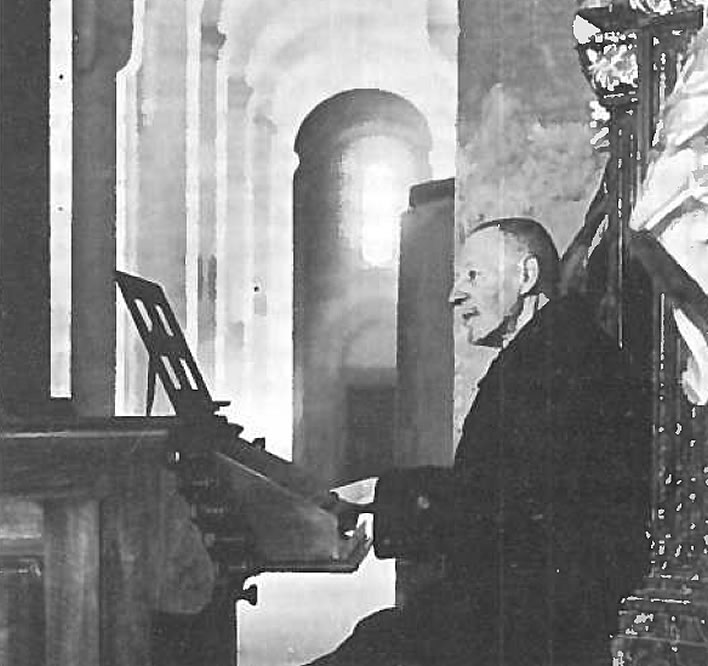
Another photograph of the organ from 1952. The organ is being played by Prof Josef Böhm, the Abbey Organist at the time.
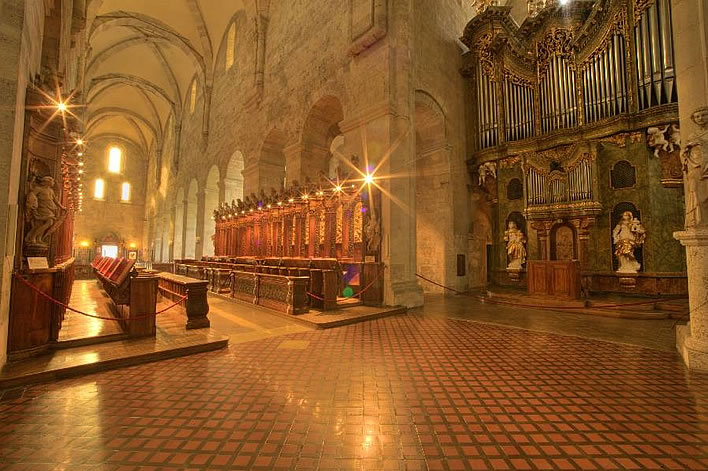
This recent photograph shows the organ in its modern position as well as a view down the nave to its original position at the western end above the door. The three windows in the west face of the nave symbolise the three aspects of the Trinity. Just outside the door as a large statue to the Holy Trinity. Image: ©Zisterzienserstift Heiligenkreuz / Österreich Journal / Michael Mössmer [and many more images at the link].
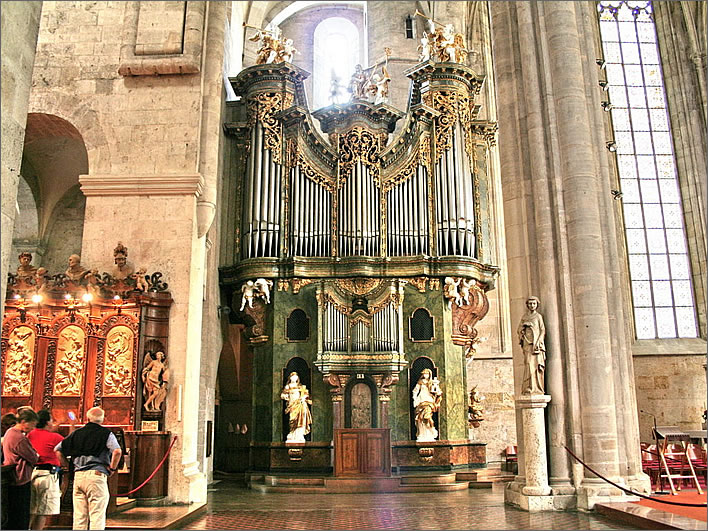
A recent photograph of the organ in its modern position showing the baroque bling in all its blinginess.
The Schubert vacuum
Would Franz Lachner invent this anecdote? It seems unlikely – but in the pursuit of our subject, we Schubertians are braced for all eventualities.
Although we have no corroboration of the story whatsoever, we can be fairly sure that Schickh's trip to Baden and then to Heiligenkreuz took place. It seems reasonably certain that Lachner and Schubert performed their pieces on Wednesday 4 June 1828. The following day was Fronleichnam, Corpus Christi, in that year. The date on Schubert's manuscript '3 June 1828' is in another's hand, but we ought to be used to that kind of irregularity by now.
It is just a pity that the only record that we possess of this outing is Lachner's brief account. Neither Schubert, Schickh nor anyone else in his party, nor the clerics from the abbey who heard the performance wrote anything down about this remarkable event – at least nothing that has survived. Where are the diarists and scribblers when we need them? Monastic archivists are clearly not what they used to be.
We don't know where Schickh and Co. stayed in Baden, how many people were in the party and who they were, what they did in Baden, who in the party went to Heiligenkreuz – all the practical details that the low-level minds on Figures of Speech would like to know.
In this vacuum of corroborative evidence, we are left wondering at the accuracy of Lachner's representation of the journey. He describes it as a jolly outing to Baden, which then had an excursion to Heiligenkreuz tacked on to it almost as an afterthought. When we reflect upon it, this view of the event strikes us as rather odd. Why would an unspecified group of people go with Schickh to Baden? Why would the two composers in the unspecified group spend their one evening in Baden – pleasure capital of Lower Austria – each scribbling down a fugue? Hardly anything in Lachner's representation makes sense.
It would make much more sense to see the outing ab initio as an excursion to see and hear the Heiligenkreuz organ, with an overnight stop in Baden on the way there. Over what happened after the impromptu concert we have no idea: did the group return to Baden or directly to Vienna? We really know so little about this event.
Why this lack of documentation? Because for everyone but Schickh and Lachner the occasion was unremarkable. The monks of Heiligenkreuz Abbey may put up an inscription to Schubert on their Kober organ for his centenary in 1928, but in 1828 no one outside a tiny circle had any idea of the strange little man's true stature. After Schubert's death the knowledge of his greatness faded to a circle of a few specialists for about forty years.
Is Lachner's anecdote true?
Some of it probably 'yes', – some of it 'perhaps' and some of it 'who knows?'
Since Lachner's anecdote is the only thing we have to work on apart from the autograph manuscript of the fugue itself, we have to look at it quite closely. Unfortunately, it stumbles and falls over the most basic questions.
For example, when was this anecdote put down on paper? Who knows?
The punctilious Otto Deutsch reproduces Lachner's anecdote undated in Section III of Die Erinnerungen seiner Freunde. This is a section full of left-over letters and scraps of paper that various biographers or would-be biographers had collected at some time or other and which may or may not have been used by someone or other.
Some have suggested that the anecdote was written in 1877. This was a time when the musicologist Sir George Grove (1820-1900), dismayed by the chaos and neglect of Schubert studies on the continent, was doing his best to collect whatever scraps he could about the great man. We mentioned his activity in our piece The mystery of the Unfinished.
Grove's friend C. A. Barry visited Lachner, then in Munich, to try and extract what he could form him. Did Lachner's Heiligenkreuz anecdote surface then? If Lachner wrote it at the time of Barry's visit, that would put the date of Lachner's anecdote as almost fifty years after the fact. Time, that curse of Schubert scholarship.
The only trouble with this hypothesis, however, is that Lachner explicitly states in the anecdote that his own fugue had 'not been published yet'.
Lachner reworked his fugue in 1835 – that is, before the final publication of Schubert's fugue – but reworking is not the same as publishing. As far as I know Lachner's fugue was first published by Edition Robert Forberg in Leipzig in 1873. This would rule out 1877 and force the dating of the written form of the anecdote to some time before 1873.
If we now take Lachner's remark at face value that Schubert's fugue had already been published, then Lachner would have to have written his anecdote after 1844. So we can tentatively say that the written anecdote dates from sometime in the thirty years between 1844 and 1873. But – the readers of Figures of Speech, swirling an ancient Armagnac around the glass, demand accuracy on such points – when exactly?
No idea.
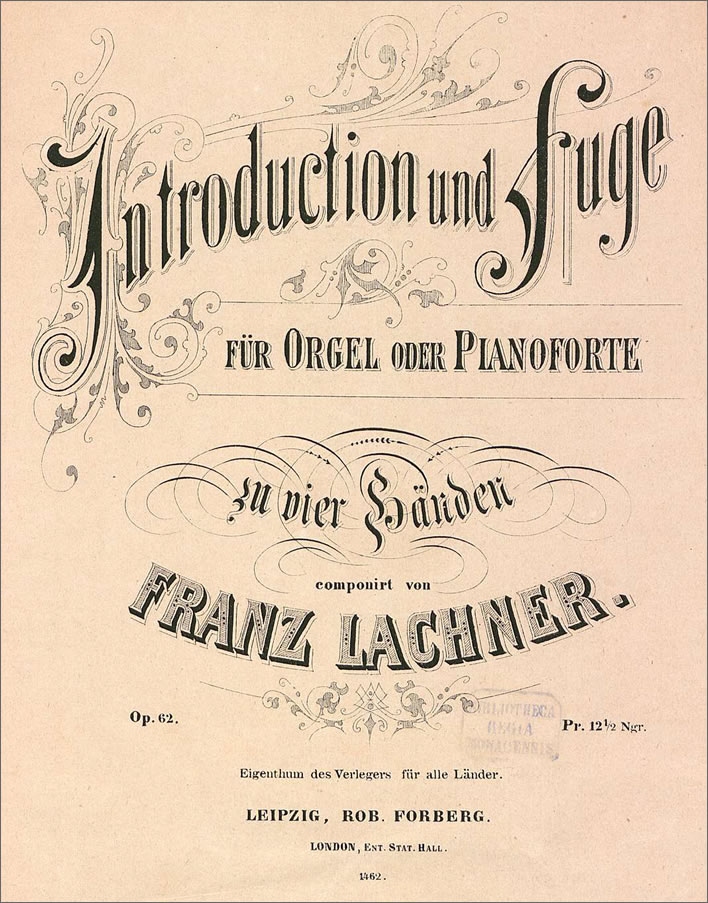
Lachner, Franz Paul: Introduction und Fuge, für Orgel oder Pianoforte; zu vier Händen; op. 62, Leipzig, [1873]. Image: MDZ.
Lachner clearly didn't write down this anecdote for his own use, but we have no idea who the recipient was.
The first to set off on a hunt for biographical materials was would-be Schubert biographer Ferdinand Luib in 1856/57, nearly thirty years after Schubert's death. When Luib found he could not proceed any further with the work he passed the materials he had collected on to Heinrich Kreissle von Hellborn at the start of the 1860s. It was Kreissle who wrote the first Schubert biography. In his 1865 edition he seemingly knows nothing about the trip to Heiligenkreuz and the creation of the E-Minor fugue, despite being in correspondence with Lachner over other matters [Kreissle p. 438].
Walter Dahms, in his 1918 biography, acknowledges the existence of Lachner's anecdote and the date on the manuscript 'Baden am 3. Juni 1828' (not in Schubert's hand, though) but has little interest in the E-Minor Fugue itself, calling it a 'schoolmasterly and lifeless piece' [Dahms p. 286].
Maurice Brown, in his Schubert, A Critical Biography in 1958, was disgusted by the level of mendacity shown by Schubert's friends, who, once his name became famous, invented much picturesque detail to demonstrate their close and indispensable friendship with the master.
Brown identifies the 'six chief offenders', among whom we find Franz Lachner's name [Brown p. 328f]. However, despite his contempt for Lachner as a witness, Brown reproduces uncritically a condensed version of Lachner's Heiligenkreuz anecdote, calling Schubert's fugue 'a mild, but not unattractive, piece'. [Brown p. 285.]
The Paris autograph score
Leaving Lachner's anecdote to one side, the other piece of evidence we have is Schubert's manuscript, now in the Bibliothèque nationale de France. Because of the fragility of the original I could only have a copy of the existing black and white microfiche images. [Click on an image to open a large version in a new browser tab 3,700 x 3,000 px]:

Vierstimmige / Fuge / in / E-moll / von / Franz Schubert / Autograph / (Aus dem Nachlass gedruckt als op. 152) / Zwei Blätter, 'Four part / Fugue / in / E-Minor / by / Franz Schubert / Autograph / (printed from the estate as Opus 152) / Two pages'
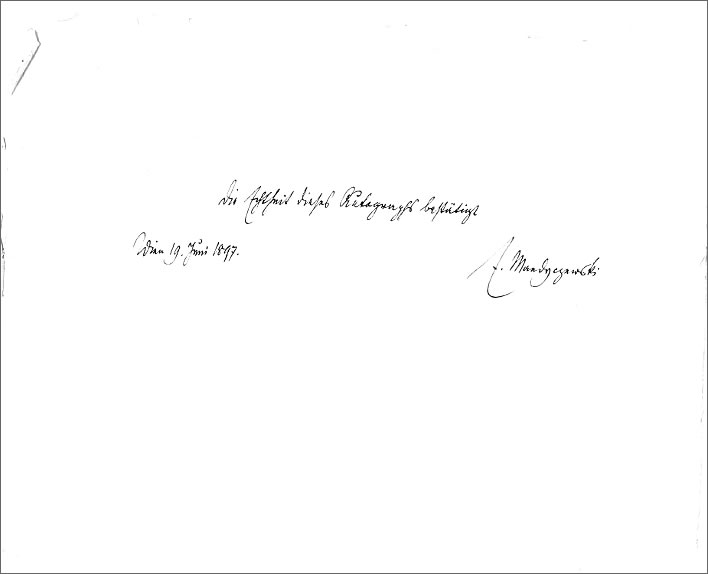
Eusebius Mandyczewski, who created the two title sheets, was the editor of the first complete edition of Schubert's works. On the second cover he wrote Die Echtheit dieses Autographs bestätigt / E. Mandyczewski / Wien 19. Juni 1897, 'The authenticity of this autograph confirmed by / E. Mandyczewski / Vienna 19 June 1897'.

Dated in an unknown hand top right above the first stave: Baden am 3. Juny 28, 'Baden [bei Wien] on 3 June [18]28'.
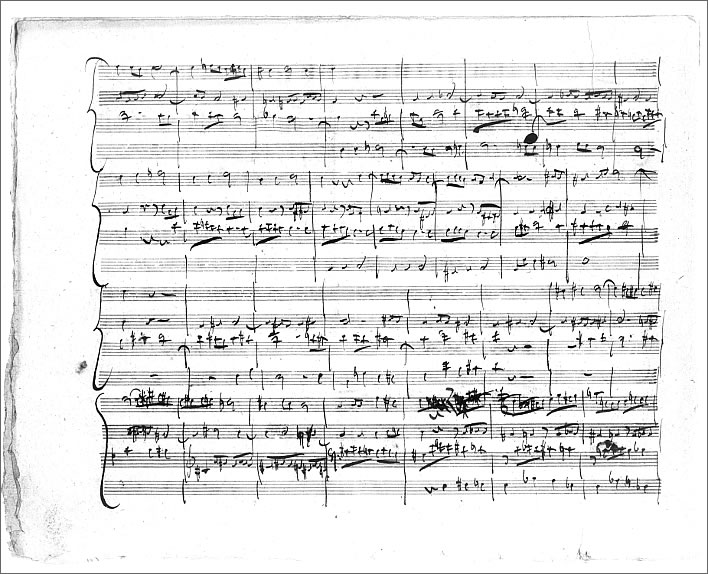
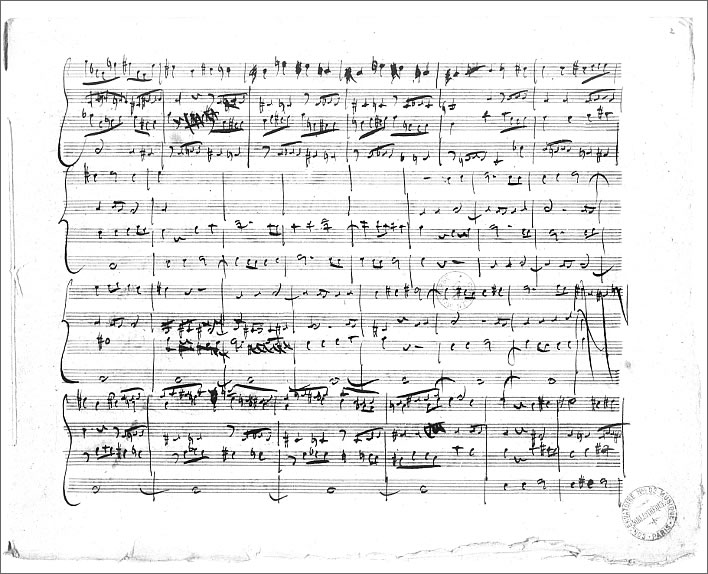
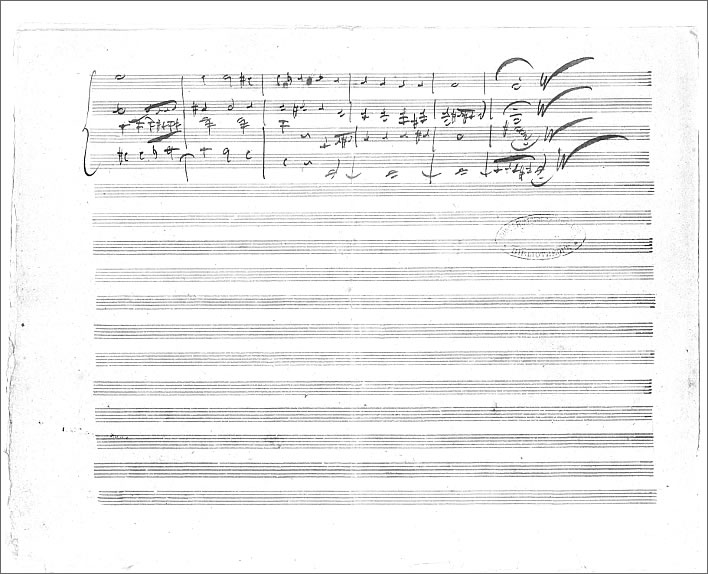
The autograph partition of Schubert's E-Minor fugue.
The paper of the authograph bears the watermark: 'A K & S' with a Fleur de lis emblem. This mark stands for A[ntonin] Kiesling und Söhne of Bohemia. Antonín Jan Kiesling (1766-1838) ran the paper mill of the Kiesling family in Hohenelbe (now Vrchlabí in the Czech Republic). Their products were widely spread in the countries of the Habsburg monarchy at that time.
Images: ©Bibliothèque nationale de France. Reproduced by permission, no further reproduction without permission. Our thanks to the BnF for their help and prompt work.
Clearing up the mess
The first thing we notice is that this autograph score is too much of a mess to be able to be played at sight.
Because of this, some speculate that Schubert must have already had a rough draft of the fugue ready before leaving for Baden. The evening of 3 June had therefore been spent transcribing a fair copy, which was used firstly in the performance, then as the manuscript for the printed version and was then finally … lost – this is Schubert studies after all.
This suggestion is reinforced by the fact that the Paris autograph has the two parts (the fugue was for four hands, remember) written above each other. We can expect a composer to do this in the initial composition in order easily to be able to keep the two parts aligned. But we would expect that for the performance that the two parts would then be written out on separate sheets (primo and secundo) so that each performer had his own score. So, not only is the manuscript scruffy, it is rather unsuitable for a four-handed performance. It still requires more work, in other words.
Furthermore, the scruffiness problem goes beyond the need for a clean score that can be played at sight, because one of the characteristics of Schubert's autograph scores is their astonishing neatness. We have mentioned Schubert's autograph tidiness in a number of contexts on this website. Schubert seems to have been able to work out in his head his compositions to a high state of finish. The scruffiness of the Paris autograph is therefore most unusual.
Those who infer from this scruffiness that what we have before us is Schubert's first working out of his fugue and that he wrote this manuscript in Vienna before his departure may have a point. As we noted above, once we clear our heads of Lachner's Landpartie [in] Baden bei Wien, 'country party in Baden', as being the main purpose of the voyage, with the trip to Heiligenkreuz as an afterthought, and view the journey instead as a trip to the Heiligenkreuz organ with an overnight stop in Baden, the suggestion that Schubert created a rough working of his fugue in Vienna before his departure makes much more sense.
The art of the fugue
Schubert had come to realise by 1828 that his grasp of counterpoint was shaky. That realisation is a discussion for another time, perhaps, but he contacted the highly respected specialist Simon Sechter (1788-1867) for some lessons on the subject. Sechter was considered to be the unequalled Viennese expert on the fugue. Schubert received his first lesson on 4 November 1828. He fell ill and died before he could do anymore.
Might the visible struggle with fugal composition evidenced by the scruffy Paris manuscript have been the trigger that convinced Schubert that he needed to brush up his technique in this area? Or might the messy autograph just be a sign of that deficit? Who knows? The only thing sure is that in order to start a barfight in a room full of Schubert scholars you only have to ask their opinions on Schubert, counterpoint and fuge.
Paper and watermarks
And finally – thank God! you will exclaim – there is yet another puzzle: from where did Schubert get the paper for this autograph ms?
In 2008, the Schubert scholar Robert Winter carried out extensive investigations of the paper used by Schubert for his scores in order to be able to work out the sequence of some Schubert compositions. According to Winter:
The watermark on this bifolium is very similar to type Vb, but its 16-stave ruling shows a total span of only 196+ to 196.5 millimetres. If the story of the fugue’s creation on 3 June 1828 is true (see D2, p. 611), then the paper supplied to Schubert may well have been purchased in Baden or provided by Franz Lachner himself.
Winter, Robert. 'Paper studies and the future of Schubert research' in Eva Badura-Skoda, Peter Branscombe, Schubert Studies: Problems of Style and Chronology, Cambridge University Press, 1982, p. 256.
Deciphering Winter's cryptic remark causes slight problems for the 'he drafted the fugue before Baden' theory. If he did write the fugue beforehand, from where did he get the unusual paper?
At the risk of pushing the reader over the edge into raving madness – and possibly spilling that excellent Armagnac – we have to note that Maurice Brown, in his 1968 paper on 'Schuberts Fuge in e-Moll' alerts us to the presence of a later autograph manuscript, in Dresden, titled Entwürfe für Fugenthemen, 'Drafts for Fugue themes' which, among some 18 fugue openings, contains five bars from the Heiligenkreuz fugue. Perhaps this was Schubert doing his homework – for himself or for Sechter.
Summing up
Our speculative conclusion is that Schickh, Schubert and Lachner (and probably no one else) decided to go to Heiligenkreuz at Schickh's expense to experience and play the magnificent organ there. Schubert – his recent encounter with the works of Georg Friedrich Händel in mind – was wanting to improve his own grasp of fugue and counterpoint, a weakness he perceived in himself.
It is quite in keeping with Schubert's serious and professional character that he should want to do this. Our knowledge of the Dresden autograph of fugue themes underscores this desire. Perhaps the opportunity to play Kober's organ in Heiligenkreuz motivated him to put theory into practice. Lachner, his close friend at the time, joined in with the project. Schubert and Lachner drafted their fugues in advance, probably writing the fair version – as Lachner suggests – during the overnight stop in Baden.
The Dresden autograph and Schubert's own obvious struggle with writing his fugue for Kober's organ show his commitment to self-improvement. The fact that barely three months after this experience he planned a series of lessons with Simon Sechter shows that he realised that there were limits to his own ability for self-improvement and that he needed the help of a specialist.
Whatever. The bottom line is that the Schubert mythology is a little richer, the Heiligenkreuz Abbey history is a little richer, we moderns are a little richer, having Schubert's E-flat fugue for four hands D 952. Poor old Schubert comes out of it – as he almost always does – empty handed.
Update 09.06.2018
Maurice Brown
When you organize your work using post-it stickers it can all too easily happen that one of these flighty things releases itself when you are not looking and flutters off to a more comfortable resting place. The miscreant now turns up and demands attention:'Brown summary'.
My post took Brown's article in the Österreichische Musikzeitschrift of 1968 ('Schuberts Fuge in E-moll' in Vol 23, pp. 65-70) generally into account, but I intended to add a few paragraphs summarising that important contribution.
Here we go, under that old Figures of Speech motto: better late than never.
Firstly, Brown was able to clarify the date at which Lachner's anecdote surfaced into the public domain: 1903.
On the occasion of the centenary of Lachner's birth, a colleague, Otto Kronseder, produced a biographical sketch of Lachner for the Altbayrische Monatsschrift. In this sketch Kronseder reproduced various anecdotes about Schubert, among which we find the anecdote of the Heiligenkreuz 'fugue challenge' that we reproduced at the beginning of our piece and which is repeated again and again wherever Schubert is featured.
Unfortunately, the problem of when and for whom Lachner retailed this anecdote is still unsolved.
Brown also inspected the very difficult to decipher autograph that is in Dresden containing Schubert's fugue drafts. This manuscript seems to have remained in the possession of the Schubert family until presumably 1890, when Schubert's half-brother Andreas added an authentication, presumably as a preliminary to selling it.
By the end of the 19th century Schubert's market value had increased enormously; his birth centenary would take place in 1897.
Schubert fans will be all to familiar with the characteristically Schubertian conclusion of this tale: the autograph was sold and effectively disappeared. We hear of it fleetingly as the ' Entwürfe für Fugen-Themen ' in a catalogue of a testamentary estate in 1928, before it submerges once more, then reappears in the inventory of the Sächsischen Landesbibliothek in Dresden.
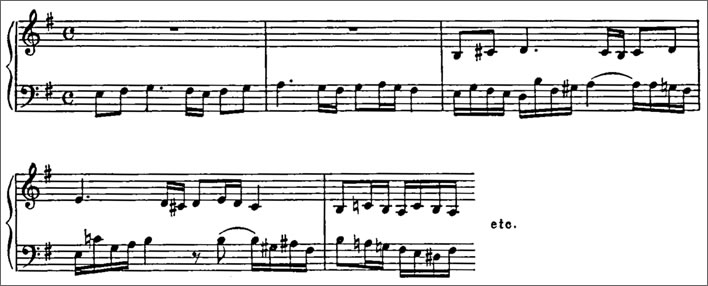
The five bar segment of fuge as transcribed by Maurice Brown from the autograph 'Entwürfe für Fugen-Themen' in the Sächsischen Landesbibliothek in Dresden.
The autograph begins with a five bar segment that is recognisable as a preparatory stage of the E-Minor fuge. The segment ends in the word 'etc.' There follow the expositions (subject-answer-countersubject) of 18 different fugues – one more testament if one were needed to Schubert's serious work ethic.
Brown makes the point that this autograph cannot realistically be a preliminary stage for the Heiligenkreuz fugue, since, apart from the five bars, scribbling 18 alternative beginnings would be just a waste of time. In other words, it is extremely unlikely that Schubert spent that evening in Baden on 3 June 1828 writing this autograph.
From the sketchy way he wrote the five bars it is clear that he would not have written this draft after the Heiligenkreuz fugue was composed; he could only have written it sometime before.
In the light of Robert Winter's work on the paper of Schubert's autographs it would be interesting to know whether the paper on which the drafts were written was the same as that of the autograph in the BnF.
Returning to the BnF manuscript we reproduced above, Brown confirms that it is highly unlikely that this autograph was used as the manuscript for Diabelli's first publication of the E-Minor fugue. It is simply too messy. Furthermore, the printed version has a number of additions and slight improvements.
Schubert must therefore have created a clean autograph score for the print version, even though we may have doubts about whether he ever wanted to publish the fugue in the first place.
But, as we pointed out, the fair copy of the draft score would have been needed for the performance in Heiligenkreuz. Neither Schubert nor Lachner could have performed the Paris autograph at the organ on that 4 June. This fair copy then served as the basis for the printed score. In November 1829 Schubert's brother Ferdinand sold this autograph to Diabelli, who kept it for a further fifteen years before finally publishing it in 1844.
Brown comes to the only conclusion that is reasonable: Schubert wrote the Paris authograph sometime before he arrived in Baden on 3 June. If any music at all was written on that evening in Baden, it was a fair copy of the primo and secundo parts that could be played by two organists prima vista. It appears that, once more, Lachner had concocted a story involving Schickh's request 'for a little something' to play on Kober's organ.
Brown also sees the Dresden autograph as a product of Schubert's intention to improve his grasp of counterpoint. He may have written it before starting his studies under Simon Sechter on 4 November 1828, or perhaps for his own enlightenment or as a preparation for or as a result of that lesson.
Who knows? Time to get out the ouija board.
Update 27.06.2018
The Sächsische Landesbibliothek / Staats- und Universitätsbibliothek Dresden (SLUB) have kindly supplied me with reproductions of the autograph of the Entwürfe für Fugen-Themen discussed above (SLUB Dresden / Digitale Sammlungen / Mus.4924-T-34).
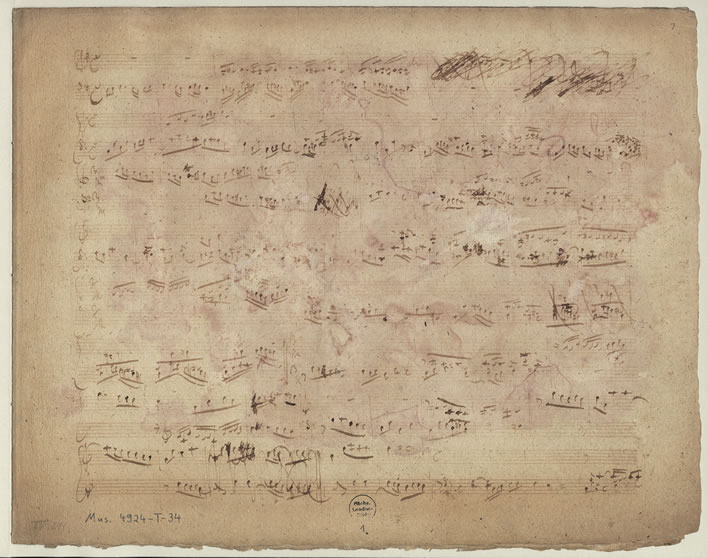
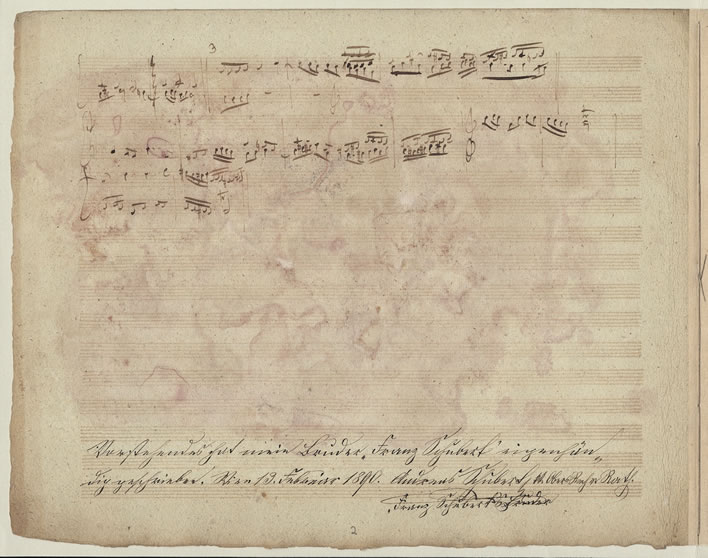
The provenance of the autograph is (sort of) confirmed by a handwritten authentication statement by Franz Schubert's half-brother Andreas:
The above was written in his own hand by my brother 'Franz Schubert'. Vienna 13 February 1890. Andreas Schubert, Imperial and Royal Senior Finance Officer. Franz Schubert's brother.
Vorstehendes hat mein Bruder 'Franz Schubert' eigenhändig geschrieben. Wien 13. Februar 1890. Andreas Schubert, k[aiserlicher.] [und] k[öniglicher.] Ober=Rech[nungs] Rath. Franz Schuberts Bruder.
Andreas Theodor Schubert (1823-1892) was the fourth child of the union of the composer's father Franz Theodor (1763-1830) and his second wife Anna Kleyenböck (1783-1860).
Franz Peter died when Andreas was five years old, so the two would have hardly known each other.
The five year old is authenticating the autograph as that of his half-brother 'written by his own hand'. Strictly speaking, it is hardly possible for Andreas to make this authentication, but anything Franz Schubert had touched was now a valuable commodity coming up to the birth centenary. Andreas was getting on by then (he would manage to live two more years), so the time had come to do some judicious cashing in of whatever scraps had fallen from the Schubert family table.
We can also see the effect of Schubert's late fame: we are told twice that the half-brother was simply his 'brother'. Even Franz's name is set in inverted commas as an act of branding: that Franz Schubert.
0 Comments UTC Loaded:
Input rules for comments: No HTML, no images. Comments can be nested to a depth of eight. Surround a long quotation with curly braces: {blockquote}. Well-formed URLs will be rendered as links automatically. Do not click on links unless you are confident that they are safe. You have been warned!